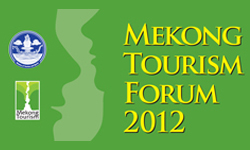Chiang Rai, June 25, 2012 – Northern Thailand strengthened its position as the Greater Mekong Subregion’s travel hub following the successful three-day Mekong Tourism Forum (MTF) in Chiang Rai, which ended on June 14. About 350 delegates from Thailand, Laos, Cambodia, Myanmar, Vietnam and China’s Yunnan Province attended the annual event, which included a two-day conference, several workshops, a small trade show and meetings of the GMS Tourism Working Group.
The theme for MTF 2012 was “20/20 Vision: Building on Two Decades of GMS Cooperation.” Organised by the Bangkok-based Mekong Tourism Coordinating Office, the event aimed to raise the profile of the GMS as a single tourist destination.

Chiang Rai, Thailand’s northernmost province, was chosen as the venue because it borders both Laos and Myanmar, and will play an important role as a bridgehead to the entire sub-region. One of the key border checkpoints allows visitors to cross from Mae Sai in Chiang Rai to Tachilek in Myanmar.
The area where the borders of the three countries converge, known as the Golden Triangle, was a focal point for opium drug wars in the 1970s and 80s. In the keynote presentation by Mom Rajawongse Disnadda Diskul, Secretary-General of the Mae Fah Luang Foundation (MFLF) under Royal Patronage, MTF delegates gained unique insights into how the area was reforested and transformed into a major producer of coffee and macadamia nuts as well as a centre for horticulture research.
Initiated in the 1980s by Her Royal Highness Princess Sri Nagarindra, the late mother of His Majesty King Bhumibhol Adulyadej, the holistic and integrated sustainable alternative livelihood development initiative has helped the hilltribe people of the Doi Tung highland area to become economically self-reliant without compromising the environment or their own cultural values.
The presentation on the development initiative was hailed by a number of the MTF delegates, including Pacific Asia Travel Association CEO Martin Craigs, as an “inspiring example of how the people of Asia could tap their own indigenous resources to solve local problems.”
MTF delegates also visited some of the attractions in the area, including the Mae Fah Luang Art & Culture Park, the Hall of Inspiration, the Hall of Opium and the former residence of the Princess Mother.
At the MTF 2012 event, representatives from Google also updated delegates on the latest marketing and travel trends. Several other speakers offered insights on community-based tourism and preparing for a significantly increasing number of visitors to the GMS. Factors contributing to this growth include the opening up of Myanmar, the outbound travel potential of China and India, the implementation of the ASEAN Economic Community (AEC) by 2015, and significant upgrades of infrastructure and transportation links, especially the Asian Highway.
The choice of Chiang Mai for the MTF 2012 event highlighted Northern Thailand’s unique cultural and historic attractions. Encouraging tourism in Northern Thailand is now a major strategic priority for the Ministry of Tourism and Sports as part of a national development policy to better balance distribution of visitors nationwide and narrow the tourism earnings gap with the rest of the country.
PATA organized the first MTF in 1996 and led it for 10 years. The event then rotated among various GMS destinations until 2005. The Mekong Tourism Coordinating Office (MTCO) revived the forum in 2010 in Siem Reap, Cambodia, while MTF 2011 took place in Laos.




